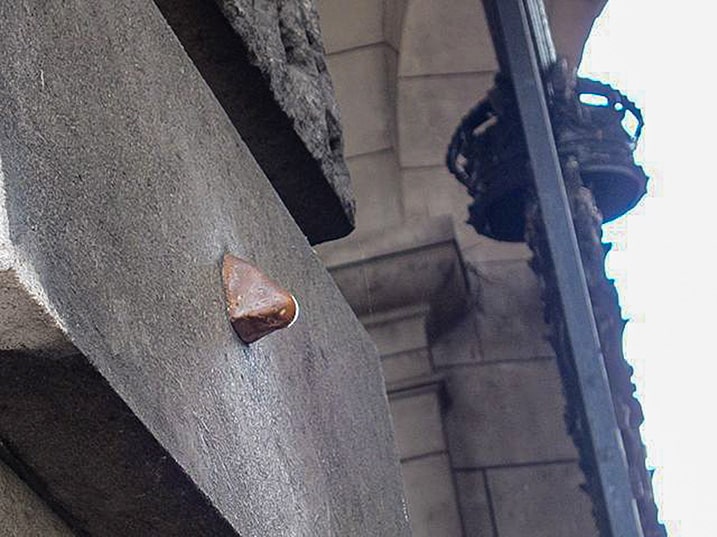
There is no shortage of quirky creative installations in England’s capital city, most of which are obvious to any passers-by due to their extensive advertising and many of which carry a hefty entrance fee. In the midst of all these commercial enterprises, a series of plaster proboscises provide an opportunity for a completely free abstract art experience right in the heart of London. Surrounded by myths as to their provenance for many years, a stroll in search of the Seven Noses of Soho provides a unique way to explore this central area – even if the catchy name is a little misleading.
The narrative of the noses began in 1997 and initially, they numbered far more than just seven. During that year, over 35 noses appeared on landmarks and public places across London, affixed overnight to such acclaimed monuments as the National Gallery, St. Pancras station and even Nelson’s Column.
Many were removed but some survived, leading to the inevitable myths perpetuated by many a London tour guide driven by the potential for a gripping story to lead to a generous tip. The most popular of these urban legends is that finding all seven noses will lead to infinite wealth, a fable that casually ignores the current impossibility of doing so.
The truth finally emerged in 2011, when an artist called Rick Buckley from Hackney in London told his story to the Evening Standard after apparently being encouraged to do so by his girlfriend, although the imminent publication of his upcoming book may have influenced his decision.
The noses signified Buckley’s belief that the increased number of CCTV cameras around the city was infringing on citizen’s civil liberties – in other words, the powers-that-be poking their noses into people’s private business. With the average Londoner being caught on camera over 300 times a day, he was inspired by the Situationist movement; a group of artists and writers who perpetrated sporadic illegal acts protesting against capitalism.
The noses, made from plaster of Paris and polymer, were moulds of Buckley’s own and were deliberately stuck under street cameras using glue hidden in a tube of toothpaste. In Buckley’s own words: “I wanted to see if I could get away with it without being detected.
The afterthought was that it would be great if these protrusions would become part of the structure themselves.” The fact that some of the noses survive to today implies that his wish has at least partially been granted.

Admiralty Arch nose pre renovation
photography by: Warden/ Wikimedia Commons
Imagination is, however, a wonderful thing and despite the real truth of the noses coming to light over a decade ago, many still prefer the fabricated folk tales. The Admiralty Arch nose in particular, perhaps because of its prominence, has at least two anecdotes associated with it.
The first is that it is a tribute to the Duke of Wellington who apparently had such a distinct facial profile that his silhouette was visible even in the fiercest of battles. The plaster nose is perfectly situated for mounted soldiers passing through the arch, who would guide their horses towards “Wellington’s nose”, giving it a rub for good luck.
The second story is just as bizarre: that the nose is a spare for the statue of Nelson situated opposite the arch in Trafalgar Square, seemingly ignoring the fact that the statue has survived the elements since 1843 without requiring any such replacement. At the time of writing, Admiralty Arch is undergoing renovation, set to become part of the 5-star Waldorf Astoria hotel. Whether the nose survives, well, who knows?

Admiralty Arch nose close up
photography by: Barcex/ Wikimedia Commons
The other six of the famous seven noses engender less tall tales but each have their own unique features – or lack thereof in the cases of the absent appendages. The original locations were: Meard Street, D’Arblay Street, Bateman Street, Dean Street, Great Windmill Street and Endell Street.
Of these, the Meard Street nose is certainly not the original and the D’Arblay Street nose could just as easily be an old curled-up masonry nail so the fact that Endell Street isn’t actually in Soho shouldn’t bother snout-seekers too much. One look at the size of the Meard Street nose explains why it can’t be part of the original installation – it is far larger than any human nose and its origin is said to be either part of a property dispute or a 2005 “Living Streets” social awareness project, giving this particular proboscis the power to sneeze at passers-by.
The Bateman Street nose may take some time to find as it is painted the same colour as the wall but it is still there, just outside a coffee bar beyond the Dog and Duck pub. The Dean Street nose sits proudly on the wall of Leonis Quo Vadis, though some reports say it is partially hidden behind a potted olive tree.
A much more obvious bright purple nose can be found on the same street but this wasn’t one of the original seven and its origins appear to be unknown. The Great Windmill Street nose is another one that is difficult to find but a keen eye will spot it alongside the Trocadero, between Shaftesbury Avenue and Coventry Street. Endell Street is in Covent Garden, not Soho but at least the nose there is easy to find, sticking out from the wall of the former Service Graphics shop.
While the noses may not correspond to any traditional art conventions, there may not be seven of them and they may not all be in Soho, their intriguing back story and the legends that still surround them at least provide an inside track that even England’s most committed city dwellers are unlikely to know.

Meard Street nose from two different angles
photography by: Betsy Weber / Flickr and Garry Knight/ Wikimedia Commons